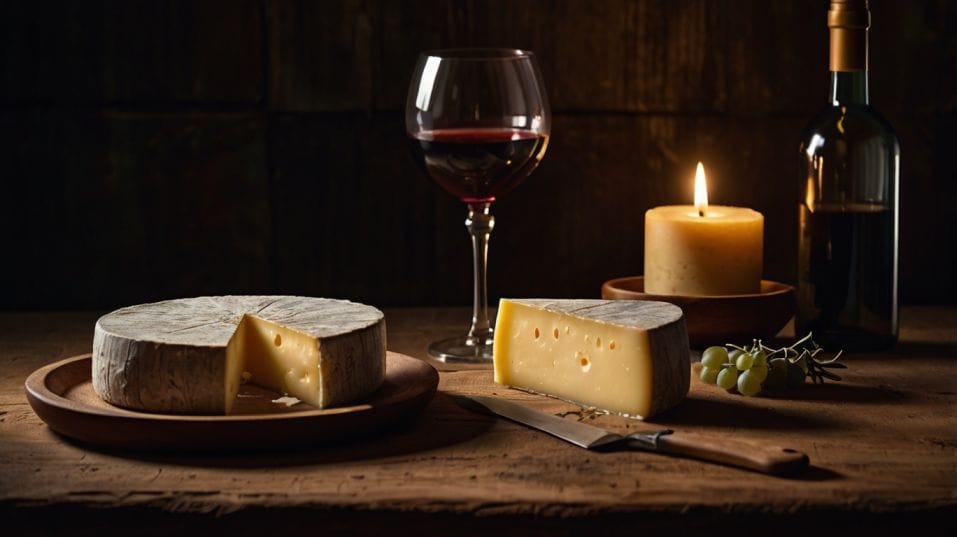Wine & Cheese Pairing for Beginners
New to wine? Learn how to pair it with cheese to build your palate, boost confidence, and taste with intention—no fluff, just flavor.

Ever wonder why some wine and cheese pairings just click? It’s not about elegance—it’s about energy.
For anyone early in their wine journey, pairing with cheese is one of the fastest, most rewarding ways to build confidence and sharpen your palate.
This beginner’s guide skips the fluff and gets right to what matters: how to taste with purpose, experiment without fear, and discover combos that make both wine and cheese shine.
Start with Contrast, Not Complication
Good pairings aren’t about matching labels—they’re about balance. Cheese brings fat, salt, and texture to the table. Wine brings acidity, structure, and aromatics.
When you line those elements up thoughtfully, even the simplest combo can feel like a discovery. Take goat cheese and Sauvignon Blanc. The cheese is creamy, tangy, and slightly chalky. The wine is bright, crisp, and herbaceous.
Together, they don’t cancel each other out—they make each other clearer. The acidity in the wine cuts through the richness of the cheese, and the cheese softens the sharpness in the wine. That’s the sweet spot you’re aiming for.
When in doubt, go for contrast over similarity. A rich triple-cream needs a lean wine to reset your palate. A sharp, aged cheese needs a wine with enough grip to handle its intensity. Contrast keeps things alive. It creates tension—the good kind.

Texture Talks First
Before you even think about flavor notes, look at what you’re pairing in terms of texture. Texture dictates how wine and cheese interact.
Soft cheeses coat your mouth. Hard cheeses crumble and linger. Bloomy rinds create a layer of funk and fat. Blue cheeses are dense and sharp. Each of these behaves differently when wine enters the picture.
Soft Cheeses and Bright Wines
Soft cheeses like brie or camembert need wines that bring energy. Sparkling wines, dry Riesling, or even young Chardonnay help cut through the fat and keep your palate engaged. If the wine is too soft or too oaky, the pairing gets muddy.
Hard Cheeses and Structured Reds
Hard cheeses—think aged Gouda or Comté—can stand up to bigger reds. These cheeses have umami, salt, and structure.
Wines with tannin, like Syrah or Cabernet Franc, meet them head-on. The fat in the cheese softens the tannin; the tannin pulls out new layers in the cheese.
There’s no need to memorize categories. Just ask: how does it feel in your mouth? If the wine washes the cheese away or gets swallowed by the richness, something’s off. Texture should be in conversation, not in competition.
Salt, Sweet, and the Long Finish
Salt is a powerful amplifier. It intensifies wine’s fruit and tempers bitterness. That’s why salty cheeses often do surprisingly well with off-dry or even sweet wines.
You don’t need a dessert course to experience this—just a piece of blue cheese and a sip of late-harvest wine can reveal it instantly.
Try pairing a salty Roquefort with Sauternes or Stilton with tawny Port. The salt tames the sweetness; the sugar rounds out the edge of the mold.
Or go simpler: Parmigiano-Reggiano with a fruity Lambrusco. The sparkle, the salt, the umami—it all locks in.
Also, pay attention to the finish. Wines with long, evolving finishes pair best with cheeses that can stay in the ring. A delicate fresh cheese will fade quickly, leaving a complex wine feeling disconnected.
Conversely, a cheese with a long, earthy finish can overpower a short, light-bodied wine. Think of it like pacing. A good match means neither one leaves the other behind.
What Grows Together Still Works
Regional pairings work for a reason. Wine and cheese that evolve together often solve pairing challenges by default. Take Loire Valley goat cheeses like Valençay or Crottin de Chavignol.
They pair effortlessly with local Sauvignon Blancs, because the flavors come from the same climate, soil, and tradition. The same holds true in Spain, where Manchego and Rioja create a savory, textured harmony.
Or in northern Italy, where Taleggio and Nebbiolo trade intensity and softness in perfect rhythm. You don’t need to be a purist—you just need to understand that geography can be a guide.
When you don’t know what to reach for, start by matching region to region. This method won’t guarantee perfection, but it will rarely steer you wrong.
Taste with Purpose
Pairing is not just eating and sipping at the same time. It’s tasting with attention. Take a bite, let it linger, then sip slowly. Watch what changes.
Does the wine feel more intense? Does the cheese get brighter or duller? Do they spark something new together, or does one flatten the other?
These small observations build your palate. You don’t need a sommelier’s vocabulary. You need curiosity and focus.
Taste in pairs. Keep the setup simple: a few cheeses, a few wines, plain crackers, maybe apples or almonds as palate cleansers. You’re not trying to impress anyone. You’re trying to understand flavor.
That understanding compounds over time. Each pairing teaches you a bit more about balance, structure, and nuance. It’s a feedback loop you can actually taste.
Final Thoughts
Wine and cheese pairing isn’t a trick—it’s a skill. And it’s one you can develop quickly when you pay attention to texture, contrast, and rhythm.
Think about what the wine needs. Think about what the cheese brings. Then taste them together, and notice what changes. Trust contrast. Use salt. Lean on regional logic. And above all, taste with intention.
Pick up a wine you’ve never tried. Buy a cheese with a name you can’t pronounce. Sit down, take your time, and find the moment where both things make each other better. That’s pairing. And it starts with your next sip.




